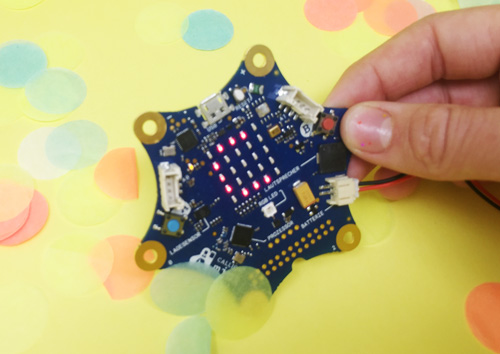* fixes for beta - hide blocks without function - digital Pin selection bring P0 in first position - add compass block to end confusion about "basic.showArrow(ArrowNames.North)" - add approved repos - add and sort preffered repos - add prefferedPackages - disable webUSB - disable parts - remove mobileSafariDownloadProtocol - update socialOptions * remove `preferredPackages` from `pxtarget` * Beta updates - removed robobit extension - updated docs menu - added about.md - added arrow icons - removed show arrow block Co-authored-by: Juri <gitkraken@juriwolf.de>
3.3 KiB
About
@description A Blocks / Javascript code editor for the Calliope mini, a pocket-size computer with 5x5 display, sensors and Bluetooth.
The Calliope mini is a pocket-size computer with a 5x5 display of 25 LEDs, Bluetooth and sensors that can be programmed by anyone.
The Calliope mini provides an easy and fun introduction to programming and making ??? switch on, program it to do something fun ??? wear it, customize it. Just like Arduino, the Calliope mini can additionally be connected to and interact with sensors, displays, and other devices.
Hardware: The Device
The Calliope mini is packaged with sensors, radio and other goodies. Learn about the hardware components of the Calliope mini to make the most of it!
~ hint
Looking to buy a Calliope mini? See the list of resellers.
~
Programming: Blocks or JavaScript
You can program the Calliope mini using Blocks or JavaScript in your web browser via the Calliope mini APIs:
input.onButtonPressed(Button.A, () => {
basic.showString("Hi!");
})
input.onButtonPressed(Button.A, () => {
basic.showString("Hi!");
})
The editor work in most modern browsers, work offline once loaded and do not require any installation.
Compile and Flash: Your Program!
When you have your code ready, you connect your Calliope mini to a computer via a USB cable, so it appears as a mounted drive (named MINI). If you are using the Calliope mini REV2 you also see another drive (FLASH) that handels up to 25 additional programs.
Compilation to ARM thumb machine code from Blocks or JavaScript happens in the browser. You save the ARM binary program to a file, which you then copy to the micro:bit drive, which flashes the micro:bit device with the new program.
Simulator: Test Your Code
You can run your code using the micro:bit simulator, all within the confines of a web browser. The simulator has support for the LED screen, buttons, as well as compass, accelerometer, and digital I/O pins.
basic.forever(() => {
basic.showString("Hi!");
})
input.onButtonPressed(Button.A, () => {
led.stopAnimation();
basic.showLeds(`
. . . . .
. # . # .
. . . . .
# . . . #
. # # # .`);
});
input.onButtonPressed(Button.B, () => {
led.stopAnimation();
basic.showLeds(`
. # . # .
# . # . #
# . . . #
. # . # .
. . # . .`);
});
Learn!
We have tons of projects, examples and courses to get your started!
Command Line Tools
Looking to use @homeurl@ in your favorite editor? Install the command line tools and get rolling!
Extensions
Create, edit and distribute your own blocks and JavaScript using extensions. Extensions are hosted on GitHub and may be written using C++, JavaScript and/or ARM thumb.
Open Source
The code for the Calliope mini is open source on GitHub. Contributors are welcome!
radio
